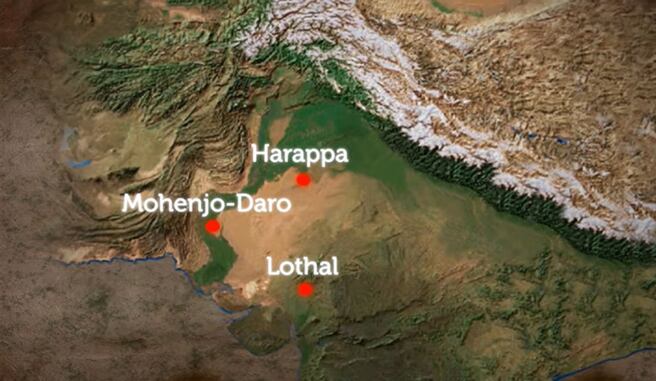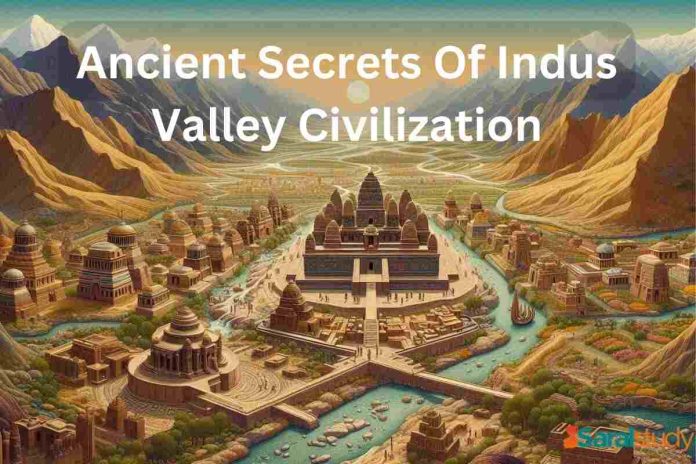The Indus Valley Civilization or the Harappan Civilization, as it is also known, is one of the earliest civilizations of the world. Located in present-day Pakistan and India, it covers more than 1.6 million square kilometres. To date, more than 2600 archaeological sites belonging to this civilization have been excavated. Some of these sites include Harappa, Mohenjo-daro, Mehrgarh and Lothal.
Phases of Development in the Indus Valley Civilization
The Indus Valley Civilization developed gradually and distinct phases can be classified. Important archaeological sites are listed after each of these phases.
- Chalcolithic phase. This lasted from 4300 to 3200 BC
- Early Harappan phase. Lasted from 3500 to 2700 BC. Sites that flourished during this period include Mohenjo-Daro, Jodhpura, Mehrgarh and Padri
- Early Harappan/Mature Harappan Transition. Lasted from 2800 to 2700 BC. Sites of this phase include Kumal, Kot Diji, Nausharo and Nari
- Mature Harappan phase. This lasted from 2700 to 1900 BC. Sites that flourished during this phase include Harappa, Mohenjo-Daro, Shortgua, Lothal, and Nari
- Late Harappan period. This period lasted from 1900 to 1500 BC. Examples of sites from this period include Lothal and Bet Dwarka.
Introduction to the Indus Valley Civilization
The first settlements of the Indus Valley Civilization were in Baluchistan and can be dated back to 3500 BC. Their settlements developed from older Chalcolithic cultures that were present in the area. The early settlements made use of mud bricks in their constructions. In addition, they also had trade relations with other civilizations.
Sites belonging to the Mature Harappan phase are situated on the Indus and its other tributaries. We can find extensive use of burnt bricks and chiselled stones in these sites. The cities of this phase were well-constructed and had citadels, stone gateways and fortified walls. Citadels have been found at Harappa and Mohenjo-daro. In addition, the cities also had vast water reservoirs. Trade links with Egypt and Mesopotamia were also established.
Harappa: A Glimpse into an Ancient City
Harappa was one of the large cities belonging to the Indus Valley Civilization (IVC). Ever since the discovery of the ruins of the city, Harappa has been a major destination for archaeologists. Today, it is one of the most well-known sites in Pakistan. It is situated on the bank of the Ravi River in the province of Punjab.

The Art and Culture of the Indus Valley Civilization
During the Mature Harappan phase, the society had three classes. These included the priests who were the religious elite, the trading class and the workers. Art was fully developed as can be evidenced from the bronze figures of men and animals. Various terracotta figurines from this period have also been discovered. In addition, toys have also been found at some sites belonging to this period.
The city of Harappa flourished between 3300 and 1500 BC. It covered an area of more than 250 acres. Some archaeologists believe that the city might have been much bigger and many portions of the city might have been eroded because of flooding of the Ravi River. Even today, many structures built during that era are intact. These include the city citadel, a granary and two cemeteries. A large number of bricks from the city were removed during the ages and thus many structures have been lost forever.
Industries and Occupations in Harappa
In the first phase of the civilization that flourished at Harappa, bead-making was the main occupation. This phase is known as the Ravi phase and lasted roughly from 3300 to 2800 BC. In the second phase which is known as the Kot Diji phase, pottery was widespread. This phase lasted from 2800 to 2500 BC. Archaeologists believe that the Indus script evolved during this period. In addition, a weight system was also developed during this period.
During the third phase i.e. the Harappan phase, beads and terracotta tablets were very widespread. This has come to light from the numerous layers of slag, blades, broken terracotta tablets and bone tools of this period that were excavated. Many of the complete tablets found elsewhere can also be dated to the same phase. Most of these tablets bear the Indus script which is yet to be deciphered.
Key Archaeological Sites of the Indus Valley Civilization
The ruins at Harappa were first discovered in 1826. Excavations began almost a century later in 1920-21 by the Archaeological Survey of India. Ram Bahadur Daya Ram Sahni and M.S. Vats led the first archaeological team in Harappa. Other famous archaeologists like Mortimer Wheeler, Richard Meadow, George Dales and J. Mark Kenoyer also conducted excavations in the later years.
Seals from this period bear symbols which may be the earliest form of writing. To date, more than 6000 inscriptions have been discovered. However, the script is yet to be deciphered. There are several theories about the language that their inscriptions encode. Some scholars believe that the language may be an older form of Dravidian while others believe that it could be some form of Sanskrit.
The earliest pottery of the Indus Valley Civilization is as old as 6000 BC. Many jars and pots have been discovered in the various sites of the Indus Valley civilization and many of these can be dated to the subsequent millennia. Copper and bronze were also known at that time and casting and hammering techniques were widely used. Evidence for metal casting comes from Harappa and Lothal. In addition, beads and shells were also used. Some sites such as Chanhu-daro indicate that bead and shell articles were mass-produced.
The people of the Indus Valley Civilization grew wheat, rice, barley and cotton. In addition, they also raised domestic animals such as buffalo, goats, sheep and chicken. They also used camels, horses, elephants and asses as beasts of burden. They were also aware of wild animals such as tigers, rhinoceros and gazelle as evident from their depictions on many seals.
Decline and Legacy of the Indus Valley Civilization
In the later periods, the Indus Valley Civilization declined. It ended between 2000 and 1900 BC due to flooding, changes in weather patterns and the decline of trade with other civilizations. Many sites were abandoned during this period.
Top 5 Interesting Facts Of Indus Valley Civilization
Here are 5 interesting facts about the Indus Valley Civilization, presented uniquely and originally:
-
Urban Planning Wizardry
Imagine ancient cities with streets so straight, they’d make modern urban planners green with envy. The Indus Valley folks weren’t just building homes; they were crafting urban masterpieces. Their cities boasted grid-like layouts that would put some of our modern metropolises to shame. Picture this: wide, ruler-straight main streets intersecting at perfect right angles, creating a chessboard of urban living. It’s as if they had some ancient GPS guiding their city blueprints!
-
The Great Bath: Prehistoric Spa Day
Hold onto your loofah! The Indus Valley Civilization didn’t just bathe; they elevated it to an art form. Enter the Great Bath of Mohenjo-daro, a colossal water tank that puts your average kiddie pool to shame. This wasn’t just a place to splash around; it was likely a center for important rituals or perhaps the world’s first spa retreat. Who knows, maybe they were pioneering the concept of “self-care” millennia before it became a hashtag!
-
Seal of Approval: Ancient Branding
The Indus Valley people were rocking their identification brand long before logos and trademarks. They created intricate seals, often featuring animals and mysterious symbols, to mark ownership or perhaps for trading. These weren’t your run-of-the-mill stamps; they were miniature works of art, each telling a story we’re still trying to decipher. It’s like they invented the world’s first emoji language!
-
Weight Watchers: Prehistoric Edition
Forget your digital scales; the Indus Valley folks had weight measurement down to a science. They used a standardized system of weights that was remarkably consistent across their vast civilization. From tiny 0.05 grams to hefty 10.865 kg, their weight game was on point. It’s as if they were preparing for some ancient bake-off where precision was key. Move over, the metric system; the Indus Valley was setting standards before it was cool!
-
The Script that Stumps: Ancient Enigma Code
Here’s a brain-teaser that’s been puzzling scholars for decades: the Indus script. This writing system, found on seals and pottery, remains undeciphered to this day. It’s like the civilization left us a cosmic crossword puzzle with no clues. Imagine leaving a message that keeps people scratching their heads for thousands of years – now that’s what you call leaving a legacy! It’s the ultimate “read this if you can” challenge from our ancient ancestors.
Also Read: Famous Temples in India

